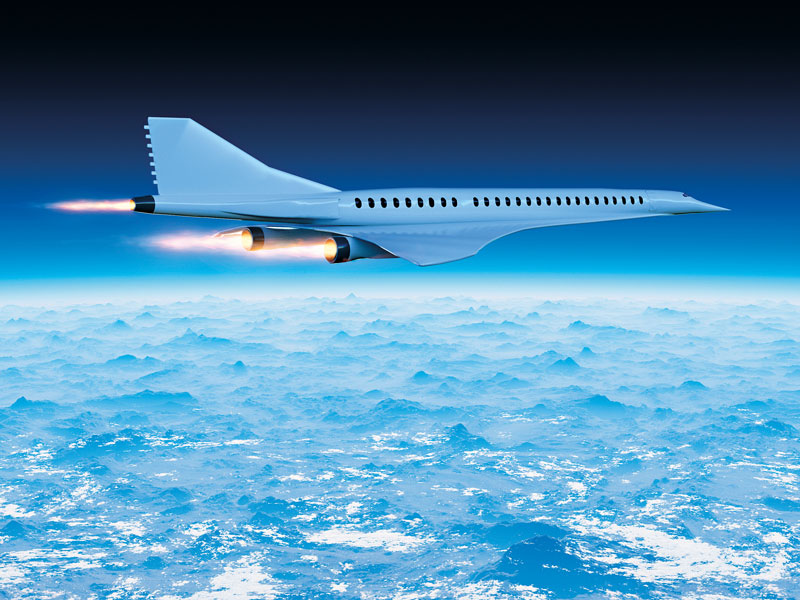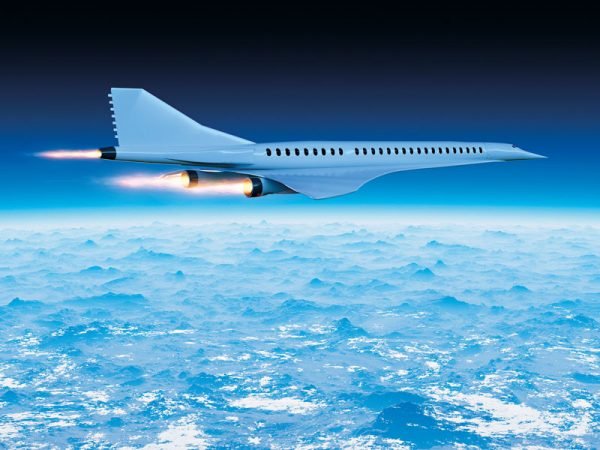
 
Author: Laura French, Features Writer
January 31, 2023
When Concorde was taken out of service in 2003, it looked like the end for three-hour hops between London and New York. Deafening sonic booms, prohibitive prices and safety concerns – fuelled by the crash in France in July 2000 – spelt the end for this headline-dominating venture, leaving many to question whether supersonic aircraft would ever take off again. But recent endeavours by the likes of Boom Supersonic, Spike Aerospace, Exosonic and Hermeus are putting the possibility of supersonic back in the spotlight – and several major airlines are getting in on the game.
In August, American Airlines announced it had placed a pre-order for 20 Overture jets from Boom, with an option to buy 40 more. Last year, United Airlines pledged to buy 15 of them, and in 2017, Japan Airlines put in a pre-order for another 20 with an initial investment of $10m.
Boom says the jets, expected to be produced in 2025 and flying by 2029, would have capacity for 80 passengers across more than 600 routes, cutting journey times to as little as half of their subsonic equivalents.
It’s not only private companies getting involved; through its Quesst programme, NASA is working on the X-59, a supersonic aircraft designed to make the notorious ‘boom’ quieter in order to avoid the pitfalls of Concorde (which was only allowed to reach supersonic speeds over the ocean).
The jet is due to fly over a handful of residential communities in the US in 2024 in order to gauge on the ground response to the sound; data will then be presented to the International Civil Aviation Organisation in a bid to get noise regulations changed. If it’s successful, that could mean opening up hundreds of new airline routes to supersonic flight.
The supersonic supporters
Those on the side of supersonic believe it could transform the way we travel in a matter of years. Boom says it could get passengers from New York to London in 3.5 hours, Tokyo to Seattle in 4.5 hours and Miami to London in less than five. Spike – which is developing an 18-passenger corporate jet that could be ready by 2028 – is said to be working on upping the speed even further, with the aim of whisking travellers between London and New York in as little as 90 minutes.
They’re also promising sustainability; Spike is aiming for net zero carbon by 2040, while Boom is targeting net zero by 2025 and claims Overture will “run on 100 percent sustainable aviation fuel, making it the first new commercial airplane capable of using 100 percent SAF.”
Both companies are also working on lowering the boom through various technologies; Boom says its jets will feature noise-reducing features including “engine updates – without afterburners – and an automated noise reduction system” to ensure take-off is no louder than subsonic planes, while Exosonic – which is working on a 70-passenger aircraft with VIP suites – claims its sound will be quieter than that of everyday traffic.
Perhaps most crucially, Boom says its prices will be relatively affordable. “Concorde was plagued with high operating costs, leading to cost-prohibitive fares and trouble filling the plane,” said a spokesperson for Boom. “We are working to make Overture profitable for airlines to fly at fares comparable to today’s business class fares, opening up supersonic travel to a much larger pool of passengers.”
Battling the headwinds
But while the proponents are painting a rosy picture, not everyone is so convinced. Among the sceptics is Bruce McClelland, Senior Consulting Analyst at Teal Group. “The problems are both economic and political,” he says. “The faster an aeroplane flies – especially supersonically – it encounters an exponential increase in drag. That requires a lot more engine thrust, which requires a lot more fuel. Concorde needed as much as eight times more fuel to move one passenger from New York to London compared to a Boeing 747, so that’s expensive.”

“There’s also the cost of developing, building and testing a plane,” McClelland says. “Development of modern jetliners runs into the multiple billions of dollars. I don’t see there being sufficient demand for a large production run, so it’s going to have to be priced pretty high. Given the physical limits, I don’t see a way to overcome this.” Prohibitively high costs were among the reasons both the US and Soviet Union developed but then abandoned their quest for supersonic flight. The only successful endeavour was Concorde, and that was funded by the British and French governments.
“Boeing was developing its own supersonic aircraft back in the 1960s, and it dropped out when it saw that the US government wasn’t going to support it,” says Kevin Michaels, Managing Director of AeroDynamic Advisory. “There are only two airlines that used Concorde – BA and Air France – and it never made money for the manufacturers that produced it,” he says. “If the manufacturer can’t make money producing it, then it’s not going to be a viable market in the long run. The economics of being part of an airline are what ends up killing you, and that was one of the biggest lessons from Concorde.”
There’s also a very large question mark over who would produce the engine. In September, Rolls-Royce announced it was pulling out of its partnership with Boom, declaring in a statement that the commercial aviation supersonic market was “not currently a priority.”
General Electric, Safran and Honeywell Aerospace have since all stated they wouldn’t be producing the engine. “That left only Pratt & Whitney, and they said it’s not core to them and their brand and they’re focusing on other projects,” says Michaels. “Engines take years and years and years of development, and a brand new one costs billions of dollars. These five companies are the only companies that have a remote chance of pulling this off technologically – so as it stands, Boom doesn’t have an engine.”
Eco-issues
Even if Boom does find an engine, there are likely to be further headwinds. Whether the issue of the sonic noise can be overcome remains to be seen – and NASA’s project likely wouldn’t be ready in time for Boom’s supposed take-off in 2029.
Current supersonic jets are limited on the distances they can fly without needing to refuel
There’s also the issue of consumer demand. Current supersonic jets are limited on the distances they can fly without needing to refuel, writing off flights across the Pacific that might have gotten consumer uptake. And, perhaps most crucially right now, many have questioned the sustainability claims – including how viable using 100 percent sustainable aviation fuel will be when stocks are still limited. “The claim that Boom’s flights will be offset by using only sustainable aviation fuel strikes me as stretching credibility,” says McClelland. “The only way that works is if the producer of a supersonic aircraft has its own source for SAF. Otherwise, operators will be forced to queue up with everyone else and take whatever they can get their hands on, most of which will probably be plain jet fuel. SAF right now is more expensive than regular jet fuel, so it just adds to the operating costs. Right now, known SAF production represents only a small fraction of a percent of the total worldwide demand for jet fuel, and the most optimistic scenario I’ve seen is that this might ramp up to 30 percent by 2050.”
At a time when consumers are becoming ever-more conscious of their environmental footprint, it’s not hard to imagine the backlash against the likes of United and American Airlines if they direct their limited SAF supply into supersonic flight – especially if, like Concorde, the jets end up consuming several times more fuel per passenger than a standard aircraft.
Lessons from Aerion
These difficulties are all too familiar for Aerion Supersonic – the business jet giant that collapsed last year. Founded in 2004 by a group of industry experts, the company was developing a $120m supersonic aircraft initially due to fly in 2029 – and it was widely considered the most viable option in the supersonic world. But it never succeeded in building an aircraft and ended up filing for bankruptcy after 17 years of trying, citing “difficulties in raising capital to achieve the next steps in the manufacture and regulatory approval of the company’s supersonic aircraft.”
“Aerion was very highly thought of in the industry,” says Michaels. “It was aimed at business aviation and charter companies rather than commercial flight, so there was a much smaller capacity. It had a really interesting design, they were extremely well-funded, and they had some of the big OEM manufacturers on board. Then one day last year, they announced chapter 11 bankruptcy, and it was over. There’s only been one successful entrant into the jetliner business globally, and that’s Embraer in Brazil,” Michaels says. “Everyone else has failed – it has the biggest entry barriers imaginable. Like nuclear reactor type entry barriers, and it’s incredibly tough. Combine that with the fact you have to overcome the other limiters for supersonic flight – the boom, the environment and the concern about carbon emissions – and these are just enormous headwinds.”
Future possibilities
None of this is to say it’s the end for supersonic altogether, of course. But the obstacles suggest that if it does ever take off again, we’re more likely to see success in the business aviation market rather than with large-scale commercial planes.
That’s at least the opinion of Michaels. “Demand for supersonic travel is there, but it’s very niche,” he says. “It doesn’t lend itself to commercial airlines. It lends itself to lower capacities, and ultra-high-net-worth individuals. So is it something that’s going to revolutionise the airline industry as we know it? I don’t think so.”
Of course, if NASA’s project is successful, sustainable aviation fuel becomes more readily available, operational costs can somehow be lowered and supersonic jets can cover longer distances, there’s still hope that we could one day be whizzing around the world in a few hours, and semi-sustainably too. But getting there by 2029 seems like more of a marketing stunt for the likes of United and American Airlines than anything else – and, sadly, we might have to wait a little longer before we’re hopping over to Australia in half a day.
